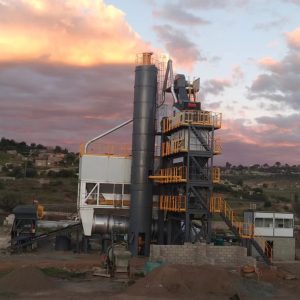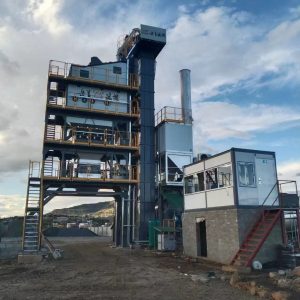The purpose of asphalt plants is to generate hot mix asphalt. These plants make use of aggregates, sand, bitumen and other such material in particular quantities to produce asphalt, which is also called blacktop or asphalt concrete.
The main activity of an asphalt mixing plant is that it heats up aggregates and then mixes them with bitumen and other adhesive substances to generate hot mix asphalt. The quantity and nature of the aggregate are dependent on specific requirements. It can be a single-sized material or a combination of numerous materials of varying sizes, along with a mixture of fine and coarse particles.
Types of Asphalt Plants
The working of asphalt plants also depends on the type of asphalt plants. Generally, there are two major types of asphalt plants. The basic purpose of all of these types is to produce hot mix asphalt. However, there are key differences between these plants in terms of the way in which they achieve the desired results and in overall working operations.
1. Batch Mix Plant


There are several aspects involved in an asphalt concrete batch mix plant. One of the most important things about such plants is the use of cold aggregate feeder bins to store and feed the aggregates in different components according to their sizes. In addition, they have an auxiliary feeder belt below each bin.
The conveyor is used to shift aggregates from one conveyor to another. Ultimately, all of the material is transferred to the drying drum. However, the aggregates also have to go through the vibrating screen to ensure the proper removal of oversized materials.
The drying drum consists of a burner unit to remove moisture and heat up the aggregates to ensure an optimum mixing temperature. An elevator is used to carry the aggregates to the top of the tower. The tower has three main units: a vibrating screen, hot bins and the mixing unit. Once the aggregates are separated by the vibrating screen according to their size, they are temporarily stored into various compartments called hot bins.
Hot bins store the aggregate in separate bins for a certain period of time and then release them into the mixing unit. When the aggregates are weighed and released, bitumen and other essential materials are often released into the mixing unit as well.
In most industrial sectors, installing air pollution control devices is essential to ensure the sustainability and eco-friendliness of the asphalt plants. Typically, bag filter units are used to trap the dust particles. The dust is often reused in the aggregate elevator.
2. Drum Mix Plant
Drum mix asphalt plants have a lot of similarities to batch mix plants. Cold bins are used in drum mix plants. Moreover, the process is identical to the batch mix plant until the aggregates enter the drum after going through the vibrating screen to separate them on the basis of their sizes.
The dram has two main functions: drying and mixing. The first part of the drum is used to heat the aggregates. Secondly, aggregates are mixed with bitumen and other filter material. It is important to note that the drum mix asphalt plant is a continuous mixing plant. Therefore, small size containers or a suitable material is used to hold the hot mix asphalt.
Since bitumen is mixed at a later stage of the production, it is first stored in separate tanks and then inserted into the second part of the drum. It is important to maintain optimum air quality to avoid pollution. For this purpose, pollution control devices like wet scrubbers or bag filters are typically used in drum mix asphalt plants.
It is evident that both of these types of plants have some common components and working procedures. For instance, feed bins are essential in both batch and continuous plants. Similarly, a vibrating screen is important in every type of asphalt plant. Other parts of the plants like bucket elevators, mixing units like drums, weighing hoppers, storage tanks, bag filters and control cabin are also important in both batch mix plant and drum mix plant.
The purpose of differentiating between these two major types of asphalt plants is to show that both types of plants produce good-quality hot mix asphalts, even if they do use different operating systems.
The type of asphalt plant that a company wants to set up is highly dependent on their business requirements, budget and the overall rules and regulations of the industrial area. For more information
Summary
Asphalt plants produce hot mix asphalt using aggregates, sand, bitumen, and other materials. The process involves heating the aggregates and mixing them with bitumen to create asphalt. There are two main types of asphalt plants: batch mix and drum mix.
Batch mix plants produce asphalt in batches, using a multi-step process that includes cold aggregate feeders, vibrating screens, and mixing units. Drum mix plants, on the other hand, operate continuously, combining drying and mixing in one drum. Both types of plants provide high-quality asphalt, with the choice depending on business needs, budget, and regulations.



